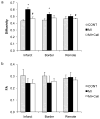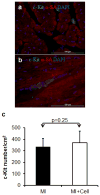The Structural Basis of Functional Improvement in Response to Human Umbilical Cord Blood Stem Cell Transplantation in Hearts With Postinfarct LV Remodeling
- PMID: 24332083
- PMCID: PMC4380875
- DOI: 10.3727/096368913X675746
The Structural Basis of Functional Improvement in Response to Human Umbilical Cord Blood Stem Cell Transplantation in Hearts With Postinfarct LV Remodeling
Abstract
Cellular therapy for myocardial repair has been one of the most intensely investigated interventional strategies for acute myocardial infarction. Although the therapeutic potential of stem cells has been demonstrated in various studies, the underlying mechanisms for such improvements are poorly understood. In the present study, we investigated the long-term effects of stem cell therapy on both myocardial fiber organization and regional contractile function using a rat model of postinfarct remodeling. Human nonhematopoietic umbilical cord blood stem cells (nh-UCBSCs) were administered via tail vein to rats 2 days after infarct surgery. Animals were maintained without immunosuppressive therapy. In vivo and ex vivo MR imaging was performed on infarct hearts 10 months after cell transplantation. Compared to the age-matched rats exposed to the identical surgery, both global and regional cardiac functions of the nh-UCBSC-treated hearts, such as ejection fraction, ventricular strain, and torsion, were significantly improved. More importantly, the treated hearts exhibited preserved fiber orientation and water diffusivities that were similar to those in sham-operated control hearts. These data provide the first evidence that nh-UCBSC treatment may prevent/delay untoward structural remodeling in postinfarct hearts, which supports the improved LV function observed in vivo in the absence of immunosuppression, suggesting a beneficial paracrine effect occurred with the cellular therapy.
Conflict of interest statement
Authors declare no conflicts of interest.
Figures







Similar articles
-
Isolated myocyte contractile function is normal in postinfarct remodeled rat heart with systolic dysfunction.Circulation. 1997 Dec 2;96(11):3974-84. doi: 10.1161/01.cir.96.11.3974. Circulation. 1997. PMID: 9403622
-
Functional and bioenergetic modulations in the infarct border zone following autologous mesenchymal stem cell transplantation.Am J Physiol Heart Circ Physiol. 2007 Sep;293(3):H1772-80. doi: 10.1152/ajpheart.00242.2007. Epub 2007 Jun 15. Am J Physiol Heart Circ Physiol. 2007. PMID: 17573463
-
Human umbilical cord blood mononuclear cells for the treatment of acute myocardial infarction.Cell Transplant. 2004;13(7-8):729-39. doi: 10.3727/000000004783983477. Cell Transplant. 2004. PMID: 15690974
-
Bioenergetic and functional consequences of bone marrow-derived multipotent progenitor cell transplantation in hearts with postinfarction left ventricular remodeling.Circulation. 2007 Apr 10;115(14):1866-75. doi: 10.1161/CIRCULATIONAHA.106.659730. Epub 2007 Mar 26. Circulation. 2007. PMID: 17389266
-
Stem cells in cardiac repair.Future Cardiol. 2011 Jan;7(1):99-117. doi: 10.2217/fca.10.109. Future Cardiol. 2011. PMID: 21174514 Review.
Cited by
-
Diffusion Tensor Cardiac Magnetic Resonance Reveals Exosomes From Cardiosphere-Derived Cells Preserve Myocardial Fiber Architecture After Myocardial Infarction.JACC Basic Transl Sci. 2018 Feb;3(1):97-109. doi: 10.1016/j.jacbts.2017.09.005. JACC Basic Transl Sci. 2018. PMID: 29600288 Free PMC article.
-
Deformation imaging to assess global and regional effects of cardiac regenerative therapy in ischaemic heart disease: A systematic review.J Tissue Eng Regen Med. 2019 Oct;13(10):1872-1882. doi: 10.1002/term.2937. Epub 2019 Sep 1. J Tissue Eng Regen Med. 2019. PMID: 31314949 Free PMC article.
-
Recent Advances in Cardiac Magnetic Resonance Imaging.Korean Circ J. 2019 Feb;49(2):146-159. doi: 10.4070/kcj.2018.0246. Epub 2018 Nov 20. Korean Circ J. 2019. PMID: 30468040 Free PMC article. Review.
-
Immunomodulation with Human Umbilical Cord Blood Stem Cells Ameliorates Ischemic Brain Injury - A Brain Transcriptome Profiling Analysis.Cell Transplant. 2019 Jul;28(7):864-873. doi: 10.1177/0963689719836763. Epub 2019 May 8. Cell Transplant. 2019. PMID: 31066288 Free PMC article.
-
Tracking stem cells with superparamagnetic iron oxide nanoparticles: perspectives and considerations.Int J Nanomedicine. 2017 Jan 25;12:779-793. doi: 10.2147/IJN.S126530. eCollection 2017. Int J Nanomedicine. 2017. PMID: 28182122 Free PMC article. Review.
References
-
- Amado LC, Saliaris AP, Schuleri KH, StJohn M, Xie JS, Cattaneo S, Durand DJ, Fitton T, Kuang JQ, Stewart G, Lehrke S, Baumgartner WW, Martin BJ, Heldman AW, Hare JM. Cardiac repair with intramyocardial injection of allogeneic mesenchymal stem cells after myocardial infarction. Proc Natl Acad Sci U S A. 2005;102:11474–11479. - PMC - PubMed
-
- Arts T, Reneman RS, Veenstra PC. A model of the mechanics of the left ventricle. Ann Biomed Eng. 1979;7:299–318. - PubMed
-
- Basser PJ. Inferring microstructural features and the physiological state of tissues from diffusion-weighted images. NMR Biomed. 1995;8:333–344. - PubMed
-
- Basser PJ, Pierpaoli C. Microstructural and physiological features of tissues elucidated by quantitative-diffusion-tensor MRI. J Magn Reson B. 1996;111:209–219. - PubMed
Publication types
MeSH terms
Substances
Grants and funding
LinkOut - more resources
Full Text Sources
Medical

